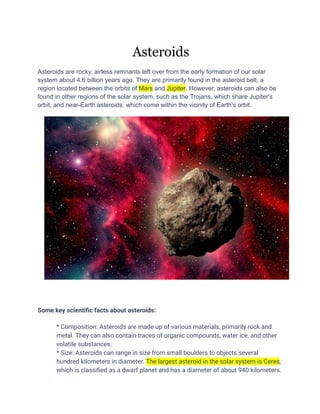Asteroids.pdf
Asteroids Asteroids rocky, airless remnants left over from the early formation of our solar system about 4.6 billion years ago. They are primarily found in the asteroid belt, a region located between the orbits of Mars and Jupiter. However, asteroids can also be found in other regions of the solar system, such as the Trojans, which share Jupiter's orbit, and near-Earth asteroids, which come within the vicinity of Earth's orbit. * Composition: Asteroids are mostly formed of rock and metal, although they also contain other components. They may also have minute amounts of water ice, chemical molecules, and other volatile substances. * Size: Asteroids can range in size from small boulders to objects several hundred kilometers in diameter. The largest asteroid in the solar system is Ceres, which is classified as a dwarf planet and has a diameter of about 940 kilometers. * Classification: Asteroids are classified into different types based on their composition, including carbonaceous, silicate, and metallic asteroids. These classifications provide insights into the asteroids' formation and evolutionary history.

Recommended
Recommended
More Related Content
Similar to Asteroids.pdf
Similar to Asteroids.pdf (20)
Recently uploaded
Recently uploaded (20)
Asteroids.pdf
- 1. Asteroids Asteroids are rocky, airless remnants left over from the early formation of our solar system about 4.6 billion years ago. They are primarily found in the asteroid belt, a region located between the orbits of Mars and Jupiter. However, asteroids can also be found in other regions of the solar system, such as the Trojans, which share Jupiter's orbit, and near-Earth asteroids, which come within the vicinity of Earth's orbit. Some key scientific facts about asteroids: * Composition: Asteroids are made up of various materials, primarily rock and metal. They can also contain traces of organic compounds, water ice, and other volatile substances. * Size: Asteroids can range in size from small boulders to objects several hundred kilometers in diameter. The largest asteroid in the solar system is Ceres, which is classified as a dwarf planet and has a diameter of about 940 kilometers.
- 2. * Classification: Asteroids are classified into different types based on their composition, including carbonaceous (C-type), silicate (S-type), and metallic (M-type) asteroids. These classifications provide insights into the asteroids' formation and evolutionary history. * Impact Hazards: Asteroids pose a potential impact hazard to Earth. Large impacts in the past have had significant effects, such as the extinction event that led to the demise of the dinosaurs. Scientists actively study and track near-Earth asteroids to identify any potential threats and develop strategies for mitigation. * Exploration and Sample Return Missions: Several space missions have been launched to study and explore asteroids. Notable missions include NASA's NEAR Shoemaker mission, which orbited and landed on the asteroid Eros, and the Japanese Aerospace Exploration Agency's Hayabusa and Hayabusa2 missions, which returned samples from the asteroids Itokawa and Ryugu, respectively. These missions have provided valuable insights into the composition, structure, and formation of asteroids. * Planetary Defense: Scientists are actively researching methods to mitigate the potential impact of asteroids on Earth. This includes techniques such as asteroid deflection, where the trajectory of an asteroid is altered to prevent a collision. Concepts like gravitational tractors, kinetic impactors, and asteroid redirection missions are being explored as possible mitigation strategies. * Resource Utilization: Asteroids are rich in valuable resources, such as metals like iron, nickel, and platinum group metals. Additionally, they may contain water ice, which can be used as a potential resource for future space exploration and colonization. Scientists are investigating methods to extract and utilize these resources from asteroids, which could support long-duration space missions and even contribute to the development of space-based industries. The Scientific understanding of asteroids continues to evolve as new missions are launched, and our exploration of these fascinating objects progresses. Ongoing research and future space missions will provide further insights into their composition, origins, and potential impact on Earth. You now more click below https://www.samigk.com